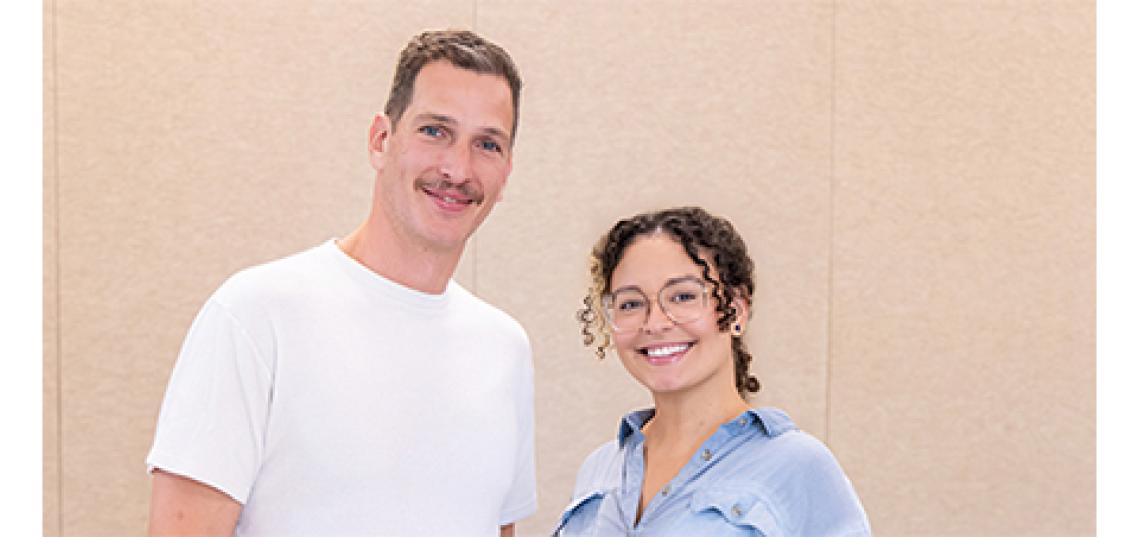
As qualitative researchers who use digital technology while working with marginalized populations, Associate Professor of Communication Jeffrey Lane and Assistant Professor of Communication Yonaira Rivera have published a paper highlighting the ways digital technologies can enable researchers conducting interviews to gain greater access to people's interactions.
The paper, “Leveraging Digital Spaces and Datafication in Communication Research: Contributions of Digital Qualitative Fluidity to Ethnographic Interviewing,” was published in a special issue of the Journal of Communication dedicated to rethinking and updating communication research, communication theorizing, and qualitative research in ways that help scholars to more effectively elevate the voices of people and groups that are often marginalized in society.
“We thought this was a pretty radical opportunity for interview research,” Lane and Rivera said, adding that the paper also takes an inventory of the changes that have happened in academia, most specifically in qualitative research, due to the rise in digitalization during and since the COVID-19 pandemic.
Providing new language to explain the value of including digital data in interviewing and ethnographic work, in the paper Lane and Rivera argue that these methods enable qualitative researchers to more effectively gain access to interview subjects spoken, or “declared” information and knowledge, as well as the “undeclared” knowledge they’ve left in their digital traces.
Noting that while many qualitative researchers are already using this kind of approach to theorize about and share the experiences of marginalized groups, the paper aims to officially bring these methods into the Communication field’s canon of research while clarifying what makes this data uniquely valuable.
Declared knowledge, they said, is the information interviewees provide as they reflect upon the researcher’s questions. While valuable, declared information is limited by what the interviewee only remembers to, or decides to, share with the researcher.
Undeclared knowledge, on the other hand, they said, can be found in the interview subject’s digital data, which are the traces the person has left through their use of personal devices and online platforms. By analyzing their subjects’ camera rolls, text messages, and social media posts, researchers can see their subjects’ interactions as they played out in real time, and how they involve other people and events across time and space. These insights provide researchers with data that goes far beyond the boundaries of the formal interview.
Noting that while many qualitative researchers are already using this kind of approach to theorize about and share the experiences of marginalized groups, the paper aims to officially bring these methods into the Communication field’s canon of research while clarifying what makes this data uniquely valuable.
“We wanted to formally argue for the critical place digital technologies, smartphones, and digital screens have in qualitative methods,” Lane and Rivera said.
Lane and Rivera said there are two reasons this is important. One reason is that using digital technologies to interview people can change the interaction in positive ways. The other reason is that understanding the subject’s personal use of digital technologies can help researchers gather richer data.
Addressing the first reason, Lane and Rivera said, “When researchers meet someone for an interview on Zoom, they are brought into the subject’s life as their lives are happening. It’s as if they are, in a sense, on hand for people's lives, even in just a short 30 or 60-minute interview. This enables the researchers to get to know and understand their subjects on a much deeper level, and this is critically important.”
When researchers do not deeply and thoroughly understand the perspectives of the audiences they are trying to speak for, Lane and Rivera said, researchers can risk either problematizing something that isn't an issue or conversely risk missing something that is a problem. The researcher could thus exclude or misconstrue valuable information, or even possibly impose their own ideas, cultural norms, reactions, and perceptions onto their subjects.
In terms of the second reason, Lane and Rivera said that when they ask interview subjects to bring up their camera rolls, social media feeds, or other technologies they naturally use, they can then incorporate these conversations and their observations of this digital communication into their data as well.
“As automation, AI, Web3, and other forms of datafied communication continue to grow, our discipline has important decisions to make about the institutionalization of digital qualitative methods as central to communication science. Digital qualitative fluidity can contribute to these conversations."
“By reviewing our subjects’ digital traces, or undeclared knowledge, with them, we can more accurately learn about their use of everyday technologies and social media. We can discover what sorts of information (or mis- or disinformation) they engage with and why, and what evidence leads them to believe it is credible information or not, and what the information means to them. We might then be surprised to discover that what is important to them about a particular post is not the actual content itself but the person who shared it with them, and the trust they have in that individual. This sort of distinction is critically important to make.”
Lane and Rivera said, “As automation, AI, Web3, and other forms of datafied communication continue to grow, our discipline has important decisions to make about the institutionalization of digital qualitative methods as central to communication science. Digital qualitative fluidity can contribute to these conversations. We thus call for our field to invest in training interested scholars at all levels on the fluid nature of qualitative inquiry on digital spaces and how methodological innovation can advance our discipline. We also need to specifically highlight the importance of institutionalizing this type of digital qualitative methods work into graduate curricula in the same way that schools and programs have taken up efforts to invest in computational sciences.”
Learn more about the Communication Department at the Rutgers School of Communication and Information on the website.
Photo credit: John O'Boyle
